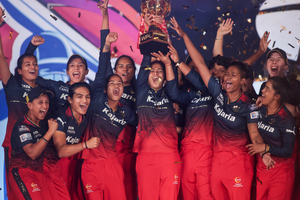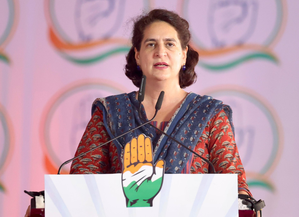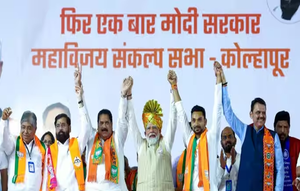New Delhi : The Women’s Premier League (WPL) concluded on Sunday night at the Arun Jaitley Stadium in Delhi, with the Royal Challengers Bangalore (RCB) crowned as the new champions in front of an electrified, sold-out crowd.
From February 23 to March 17, fans in Delhi and Bengaluru witnessed exhilarating batting, impressive bowling, versatile all-round performances, and nail-biting last-ball finishes that left a lasting impression.
While WPL 2023 came and went quickly for all teams, the 2024 edition provided teams with valuable time and experience from the previous year’s tournament, allowing them to thoroughly prepare for the spectacle. Many pre-season camps, focusing on both skill and conditioning aspects, meant the players came more prepared than ever to put their best foot forward.
In the bowling department, WPL 2024 saw purple cap winner Shreyanka Patil (13 wickets), Asha Sobhana (12 wickets), Tanuja Kanwer, Deepti Sharma and Radha Yadav (10 scalps each) be amongst the top wicket-takers in the competition, with their economy rate being just a shade above 7.
“One of the biggest points from WPL 2024 has been domestic bowlers understanding bowling in different phases. It’s one thing that they are good domestic bowlers, but it’s another thing to bowl out of their respective comfort zone and that made for good growth.
“The ability to pick up wickets from the Indian bowlers has increased and more so, role-specific bowling has been very effective. For example, Arundhati Reddy and Pooja Vastrakar did the good job of containing batters in the middle overs.
“Then, one can look at Asha Sobhana, who comes after first ten overs, and became very impactful. Plus, Tanuja Kanwer was very impactful with the new ball and Shreyanka Patil evolved so well.
“Like, last year, she was an exclusive death-overs bowling option and this time, she came early to bowl in the eliminator and final, so her growth has been very interesting to see in terms of ability and adapting herself to bowling in various phases of the game.
“She’s a very competitive person, but to be successful in it is yet another thing and her success is more defining at the moment,” said Aarti Sankaran, a Chennai-based former cricketer turned coach, who worked as a broadcaster in the tournament.
Regarding the batting department, a sizeable gap still exists between Indian international batters and domestic players. Shafali Verma, Smriti Mandhana, Deepti Sharma, Harmanpreet Kaur, Richa Ghosh, Jemimah Rodrigues, and even Yastika Bhatia had scintillating time with the bat to be amongst top ten run-scorers in the competition.
“In my eyes, only Poonam Khemnar and Sajana Sajeevan have been able to bridge that gap quickly. I liked how Jemimah Rodrigues adapted herself as a T20 batter within her limitations. Shafali Verma sorted her technical issues and got better in the tournament, while Smriti Mandhana working on that match-up against off-spin is nice to see.
“Richa Ghosh and Yastika Bhatia have evolved very nicely in last six months, with their WPL 2024 showings being an extension of it. If the domestic batters have to reach a certain level, they need to change certain things about themselves, which is not entirely in their hands as far as domestic cricket is concerned,” pointed out Aarti.
She believes domestic teams and coaches should now figure out batters for different formats and roles. “Making 190 in a T20 game is possible and people are chasing it down. But domestic scores average is still 130, and that’s a big 60-run difference, which has to be brought down. It also means coaches need to work on developing players for specific roles.
“Not everybody is like Shafali to be gung-ho about opening the batting in T20s and 50-over games. Most of the domestic teams open with the same set of players, and how does that make sense? We need to start developing specific players for specific formats. If you are looking to compete with an Australia, England or New Zealand, you must do this.”
So how can the domestic batters try to bridge the batting cap ahead of next year’s WPL? “One they should do is, increase the level of competitiveness in their practice. They need not be entirely dependent on the domestic circuit alone; then can enhance themselves by doing a little bit more. They have to practice one level up and their preparation has to be many levels up.
“If they are aiming for representing India, they also need to try playing against boys who are probably on par with one level up from your international players. It will help them cope up when playing with or against international players. You are practising two levels below international standard, so how do you expect to go there & be brilliant?
“You have to find ways of doing it and a lot of it has to do with initiative by the players, coaches and teams. Suppose if I were with a team, I would make the players play against U16 boys and even if they lose, they will get a way to increase their level by seeing where they are currently and what has to be done to reach that high standard,” stated Aarti.
Apart from batting, fielding is still an aspect that needs immense work. Indian players dropped 33 catches in the tournament, compared to overseas players shelling 25 chances. While Gujarat Giants had 77% catching efficiency, UP Warriorz had just 62% in that aspect and couldn’t hold on to their chances aplenty.
“The fielding quality was very ordinary in the tournament, like Shreyanka dropped a sitter of a catch of Shafali in the DC-RCB game at Bengaluru, which was completely unacceptable. Even the foreign players were abysmal in their fielding standards. Everyone needs to pull up their socks and work on improving their fielding.
“When defending a low total, the fielding has to be top-notch – for example, in the final, DC took the game to the last over, their fielding was good and even RCB defended 135 against MI on back of their fielding show.
“Fielding was one of the reasons why many low or par totals weren’t defended too well. In a venue, like say Chennai, you get low totals, so teams have to field well in defence of a low total,” elaborated Aarti.
One of the most notable aspects of WPL 2024 is the remarkable contribution of the regular figures in the Indian team in the wonderful performances of their franchises. “Teams who did well were driven by contributions from their Indian players. Like, DC had Jemimah, Shikha, Arundhati amongst others performing, irrespective of the foreign contribution.
“Fortunately, for DC, MI & RCB, their Indian players were all international cricketers and had very few uncapped players. WPL 2024 also showed that age is no barrier and that domestic experience is of immense value, which is very crucial. The players who have spent a lot of time in domestic circuit, were able to adapt better,” concluded Aarti.






Related Posts
Rasikh and Mukesh pick three-fers as Delhi Capitals beat Mumbai Indians by 10 runs
LSG v RR head-to-head; When and where to watch
Mayank Yadav likely to play against Rajasthan Royals